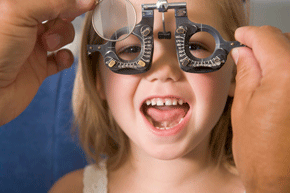Eye Exams for Children–Are They Really Necessary?
 We all want the absolute best for our children. We want them to be happy, healthy and to succeed in whatever they choose to do in their lives. One of the responsibilities of parenthood is providing a healthy environment where our children can learn and grow. One of the most important ways we learn about our world is by observation. Just spend a few minutes watching babies or young children and this becomes obvious. It has been estimated that as much as 80% of the learning a child does occurs through his or her eyes. It’s interesting that babies learn to see over a period of time—just like they learn to walk and talk. They are not born with the ability to focus their eyes, move them together, or use the information the eyes send to the brain to help understand the world around them.
We all want the absolute best for our children. We want them to be happy, healthy and to succeed in whatever they choose to do in their lives. One of the responsibilities of parenthood is providing a healthy environment where our children can learn and grow. One of the most important ways we learn about our world is by observation. Just spend a few minutes watching babies or young children and this becomes obvious. It has been estimated that as much as 80% of the learning a child does occurs through his or her eyes. It’s interesting that babies learn to see over a period of time—just like they learn to walk and talk. They are not born with the ability to focus their eyes, move them together, or use the information the eyes send to the brain to help understand the world around them.
Without good vision, a child’s ability to learn becomes more difficult. Vision problems affect 1 in 20 preschoolers and 1 in 4 school-age children. Since many vision problems begin at an early age, it is very important that children receive proper eye care. Untreated eye problems can worsen and lead to other serious problems—decreased learning ability, personality and adjustment problems in school. Some children with learning difficulties appear hyperactive and easily distracted and are often labeled as having Attention Deficit Hyperactivity Disorder (ADHD). However, untreated vision problems can cause some of the same behaviors attributed to ADHD, resulting in some children being misdiagnosed.
Because vision may change frequently during preschool and school years, regular eye and vision care is important. Parents play an important role in helping to assure their child’s eyes and visual ability develop properly. Here are a few guidelines to consider:
During a baby’s first two months of life, it is not unusual for the eyes to appear to wander or be crossed. However, if an eye appears to turn in or out constantly, an evaluation is warranted. Babies should begin to follow moving objects with their eyes and reach for things by about 3 months of age. Hanging mobiles or objects across the crib, playing peek-a-boo, patty cake, and playing with blocks or balls that can be held in small hands can help stimulate and develop hand-eye coordination and visual memory. Important clues to watch for include excessive tearing (which may indicate blocked tear ducts), red or irritated eyelids, constant eye turning, or the appearance of a white pupil. Baby’s first eye exam is usually scheduled at about 6 months.
In the toddler years, control of eye movements and eye-body coordination skills continue to improve. Rolling a ball back and forth, playing with building blocks in different shapes and sizes, reading and telling stories all play a part in developing visually-guided eye-hand-body coordination, fine motor skills and visual perception necessary to learn to read and write. Parents need to be watching for any signs of vision problems or any sign of eye muscle problems (crossed eyes or eyes not properly aligned). Early detection and treatment of any problem is extremely important in preventing permanent vision loss.
Preschool years are a time for fine-tuning the visual abilities gained thus far and continuing to develop the visual abilities needed in school and throughout the rest of life. It is especially important for parents to watch for difficulty recognizing colors, shapes, letters, or numbers; squinting or tilting the head; frequent eye-rubbing; difficulty with eye-hand-body coordination when playing ball or riding a bike; short attention span for the child’s age; sitting close to the TV or holding books very close; turning of an eye in or out. If you notice any of these symptoms, schedule an appointment with your eye doctor.
As children progress in school, they face increasing demands on their visual abilities. The size of print in books becomes smaller and the amount of time reading and studying increases significantly which places increased demands on the child’s eyes. When certain visual skills have not developed or are poorly developed, learning is difficult and stressful and children will typically avoid reading and doing near visual work or do it with a lowered level of comprehension or efficiency. They may also fatigue quickly and have a short attention span when doing schoolwork. While school vision screening programs are helpful in identifying children with vision problems, they cannot replace a comprehensive eye and vision examination.
Summer provides a great time for families to play together and enjoy our great outdoors. It also gives parents a great opportunity to observe children at play. Should you detect any problems with hand-eye coordination or depth perception, an hour spent with your eye doctor can make a significant difference in your child’s quality of life.

Comments